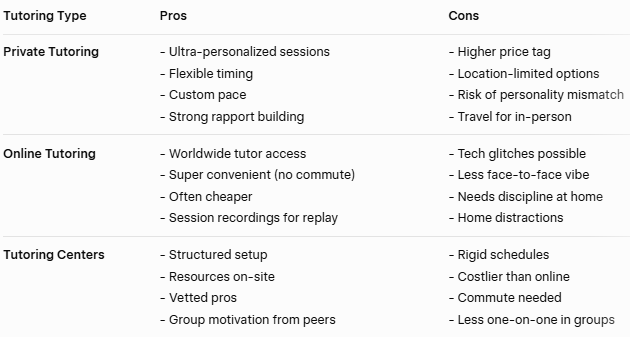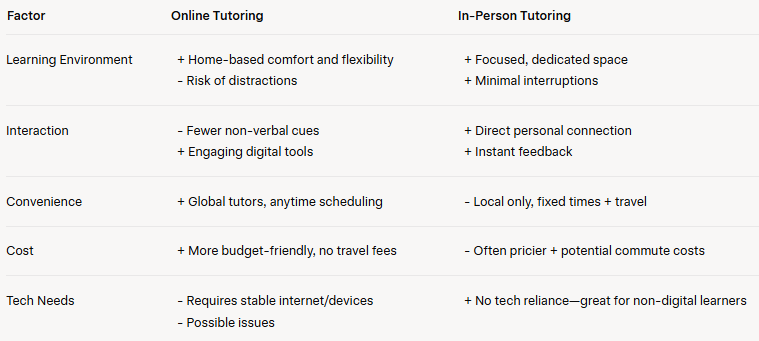Parent Guide: Find the Right Tutor for Your Child in 5 Easy Steps
Quick Answer: To find the perfect tutor, start by defining your child's goals, explore tutoring options (online vs. in-person), vet candidates thoroughly, test with a trial session, and build an ongoing partnership. Follow these steps for fast results and lasting academic success.
As a busy parent, you want actionable advice that delivers results without wasting time. Tutoring provides personalized support, boosts grades, builds confidence, and sparks a love for learning—often transforming struggles into strengths. This guide cuts straight to the essentials, with clear steps, pros/cons tables, checklists, and free downloadable templates to make your search seamless.
Ready to get started? Download our free Educational Goals Template
Step 1: Define Clear Goals (Start Here for Immediate Clarity)
Action First: List your child's top 3 academic needs right now—e.g., mastering algebra, acing SATs, or improving study habits. Share these with potential tutors to align efforts from day one.
Why It Matters
Clear goals act as your roadmap, ensuring the tutor focuses on what truly helps your child thrive. Without them, sessions can feel scattered and ineffective.
Quick Actions:
- Assess Challenges: Pinpoint specific issues like math anxiety, essay writing gaps, or focus problems. Consider personal factors too—low motivation or confidence can block progress.
- Involve Your Child: Ask them what they need; this builds buy-in and reveals hidden struggles.
- Pro Tip: Use our template to document goals and track them over time.
Download Now: free Educational Goals Template
Step 2: Explore Tutoring Options (Compare and Choose Fast)
Action First: Decide between online, in-person, or hybrid based on your child's learning style—tech-savvy kids often excel online, while hands-on learners prefer face-to-face.
Key Types of Tutoring
Match the format to your family's schedule and your child's needs for the best fit.

Online vs. In-Person: Side-by-Side Comparison
Weigh these factors against your situation—online wins for flexibility, in-person for interaction.

Best For
Digital subjects, self-starters
Hands-on topics, those needing direct guidance
Quick Assessment Checklist:
- Your child's learning style (visual, hands-on?)
- Tech comfort level
- Schedule constraints
- Subject specifics (e.g., lab-based vs. reading-heavy)
Step 3: Vet Tutors Thoroughly (Avoid Common Pitfalls)
Action First: Create a 5-point checklist for each candidate: qualifications, experience, reviews, compatibility, and rates. Narrow to 3-5 options before trials.
Credentials Checklist
- Qualifications: Degree in the subject or teaching certification?
- Experience: Years teaching your child's age/subject? Success with similar challenges?
- Compatibility: Personality match—patient, engaging, adaptable?
- Background: Clean checks and references?
Dig Deeper with Profiles and Reviews
Scan for red flags or gems: Look for mentions of customized plans, fun teaching methods, or proven results. Read reviews for patterns—consistent praise for patience? Avoid tutors with vague profiles.
Step 4: Test with a Trial Session (See It in Action)
Action First: Book a 30-minute free or low-cost trial. Observe engagement and ask your child for feedback immediately after.
What to Watch For
- Rapport: Does the tutor connect? Patient and encouraging?
- Style: Interactive vs. lecture-heavy? Adapts to your child's pace?
- Effectiveness: Covers goals? Sparks interest?
Pro Tip: Record online trials (with permission) for review. If it's not a fit, move on - no commitment needed.
This step saves time and money by confirming the match early.
Step 5: Build a Strong Partnership (Track and Optimize)
Action First: Set weekly check-ins with the tutor, define success metrics (e.g., grade improvements), and adjust sessions as needed.
Communication Essentials
- Share expectations upfront: Session frequency, progress updates, payment terms.
- Involve everyone: Regular feedback from you, your child, and the tutor.
Monitoring Progress
- Track Wins: Note confidence boosts, better homework habits, or test scores.
- Adjust Flexibly: If needs change (e.g., new subject), tweak the plan.
- Long-Term Mindset: Reinforce lessons at home and celebrate milestones.
Quick Review Checklist:
- Goals met so far?
- Child's engagement level?
- Tutor's responsiveness?
Final Thoughts: Make Your Decision with Confidence
Reflect on progress every 4-6 weeks: Has your child improved? Are they more motivated? If yes, nurture the partnership for long-term gains. If not, refine or switch—tutoring is about results.
Ready to get started? Download our free Educational Goals Template